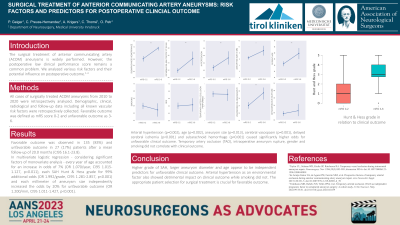Surgical treatment of anterior communicating artery aneurysms: risk factors and predictors for postoperative clinical outcome
Surgical Treatment of Anterior Communicating Artery Aneurysms: Risk Factors and Predictors for Postoperative Clinical Outcome
Friday, April 21, 2023


Philipp Geiger, MD (he/him/his)
Resident
Department of Neurosurgery at the Medical University Innsbruck
ePoster Presenter(s)
Introduction: The surgical treatment of anterior communicating artery aneurysms is widely performed. However, the postoperative low performance score stays a common problem. We analyzed various risk factors and their potential influence on postoperative outcome.
Methods: All cases of surgically treated ACOM aneurysms from 2010 to 2020 were retrospectively analyzed. Demographic, clinical, radiological and follow-up data including all known vascular risk factors were retrospectively collected. Favorable outcome was defined as mRS score 0-2 and unfavorable outcome as 3-6.
Results: Favorable outcome was observed in 135 (83%) and unfavorable outcome in 27 (17%) patients after our mean follow-up of 20.0 months (CI95 16.1-23.8).
Arterial hypertension (p=0.002), age (p=0.002), aneurysm size (p=0.013), cerebral vasospasm (p=0.001), delayed cerebral ischemia (p < 0.001) and subarachnoid hemorrhage (p < 0.001) caused significantly higher odds for unfavorable clinical outcome. Temporary artery occlusion (TAO), intraoperative aneurysm rupture, gender and smoking did not correlate with clinical outcome.
In multivariate logistic regression considering significant factors of monovariate analysis, every 10 years of age provided 7% additional odds (OR 1.070/year, CI95 1.015-1.127, p=0.011), each SAH Hunt & Hess grade provided 99% additional odds (OR 1.992/grade, CI95 1.281-2.857, p< 0.001) and each millimeter of aneurysm size independently provided 20% additional odds for unfavorable outcome (OR 1.200/mm, CI95 1.011-1.427, p< 0.001).
Conclusion : Higher grade of SAH, larger aneurysm and age appear to be independent predictors for unfavorable clinical outcome. Arterial hypertension as an environmental factor showed also detrimental impact on clinical outcome, while smoking was irrelevant. The appropriate patient selection for surgical treatment is crucial for favorable outcome.
Methods: All cases of surgically treated ACOM aneurysms from 2010 to 2020 were retrospectively analyzed. Demographic, clinical, radiological and follow-up data including all known vascular risk factors were retrospectively collected. Favorable outcome was defined as mRS score 0-2 and unfavorable outcome as 3-6.
Results: Favorable outcome was observed in 135 (83%) and unfavorable outcome in 27 (17%) patients after our mean follow-up of 20.0 months (CI95 16.1-23.8).
Arterial hypertension (p=0.002), age (p=0.002), aneurysm size (p=0.013), cerebral vasospasm (p=0.001), delayed cerebral ischemia (p < 0.001) and subarachnoid hemorrhage (p < 0.001) caused significantly higher odds for unfavorable clinical outcome. Temporary artery occlusion (TAO), intraoperative aneurysm rupture, gender and smoking did not correlate with clinical outcome.
In multivariate logistic regression considering significant factors of monovariate analysis, every 10 years of age provided 7% additional odds (OR 1.070/year, CI95 1.015-1.127, p=0.011), each SAH Hunt & Hess grade provided 99% additional odds (OR 1.992/grade, CI95 1.281-2.857, p< 0.001) and each millimeter of aneurysm size independently provided 20% additional odds for unfavorable outcome (OR 1.200/mm, CI95 1.011-1.427, p< 0.001).
Conclusion : Higher grade of SAH, larger aneurysm and age appear to be independent predictors for unfavorable clinical outcome. Arterial hypertension as an environmental factor showed also detrimental impact on clinical outcome, while smoking was irrelevant. The appropriate patient selection for surgical treatment is crucial for favorable outcome.
